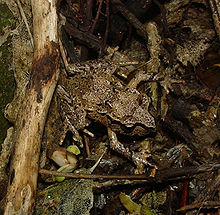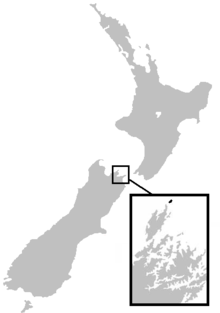Hamilton's frog
| Hamilton's frog | |
|---|---|
 |
|
| Scientific classification | |
| Kingdom: | Animalia |
| Phylum: | Chordata |
| Class: | Amphibia |
| Order: | Anura |
| Family: | Leiopelmatidae |
| Genus: | Leiopelma |
| Species: | L. hamiltoni |
| Binomial name | |
|
Leiopelma hamiltoni McCulloch, 1919 |
|
 |
|
| Range of Leiopelma hamiltoni. | |
Hamilton's frog (Leiopelma hamiltoni) is a primitive frog native to New Zealand, one of only four extant species belonging to the family Leiopelmatidae. The male remains with the eggs to protect them and allows the tadpoles to climb onto his back where they are kept moist. It is named after Harold Hamilton, its discoverer. The holotype is in the collection of the Museum of New Zealand Te Papa Tongarewa.
Despite being New Zealand’s largest extant native frog, Hamilton’s frog is a small species when compared to frogs from around the world, with males reaching a total length of up to 43 mm and females being larger at 52 mm. They are mostly light brown in colour, although some green individuals have also been observed. A single dark stripe runs along each side of the head and through the eye. There is no webbing between the hind toes, and the fingers are not webbed.
Hamilton's frog survive only on a small rocky area on mammal-free Stephens Island in the Cook Strait. Sub-fossils indicate Hamilton’s frog once lived throughout the lower North Island and upper South Island. They live around rocky, moist and grassy areas.
Hamilton’s frog is a ground-dwelling species that is nocturnal. It shelters in damp crevices during the day. They can be difficult to locate because they are well camouflaged, nocturnal, do not croak and very rare. They do not go through tadpole stages but instead they develop totally within a gelatinous capsule in the egg, hatching out as froglets. They take around three years to reach maturity. The Hamilton's frog are insectivores. They feed on fruit flies, small crickets, moths, and springtails. Juveniles with a snout-vent length of 20 mm or less lack teeth, and thus are required to eat soft-bodied arthropods like mites and fruit flies.
...
Wikipedia

